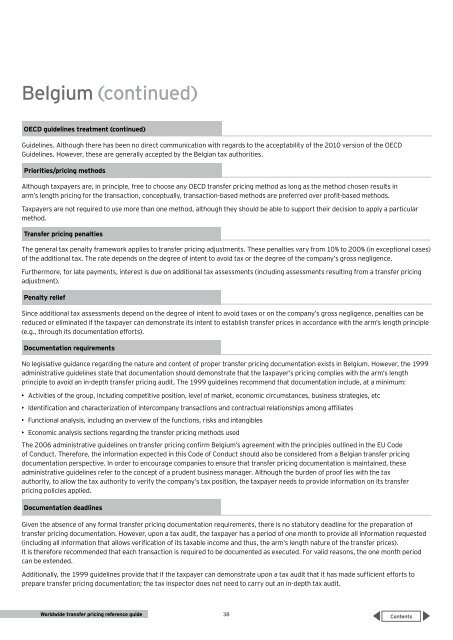Worldwide transfer pricing reference guide 2014
Create successful ePaper yourself
Turn your PDF publications into a flip-book with our unique Google optimized e-Paper software.
Belgium (continued)<br />
OECD <strong>guide</strong>lines treatment (continued)<br />
Guidelines. Although there has been no direct communication with regards to the acceptability of the 2010 version of the OECD<br />
Guidelines. However, these are generally accepted by the Belgian tax authorities.<br />
Priorities/<strong>pricing</strong> methods<br />
Although taxpayers are, in principle, free to choose any OECD <strong>transfer</strong> <strong>pricing</strong> method as long as the method chosen results in<br />
arm’s length <strong>pricing</strong> for the transaction, conceptually, transaction-based methods are preferred over profit-based methods.<br />
Taxpayers are not required to use more than one method, although they should be able to support their decision to apply a particular<br />
method.<br />
Transfer <strong>pricing</strong> penalties<br />
The general tax penalty framework applies to <strong>transfer</strong> <strong>pricing</strong> adjustments. These penalties vary from 10% to 200% (in exceptional cases)<br />
of the additional tax. The rate depends on the degree of intent to avoid tax or the degree of the company’s gross negligence.<br />
Furthermore, for late payments, interest is due on additional tax assessments (including assessments resulting from a <strong>transfer</strong> <strong>pricing</strong><br />
adjustment).<br />
Penalty relief<br />
Since additional tax assessments depend on the degree of intent to avoid taxes or on the company’s gross negligence, penalties can be<br />
reduced or eliminated if the taxpayer can demonstrate its intent to establish <strong>transfer</strong> prices in accordance with the arm’s length principle<br />
(e.g., through its documentation efforts).<br />
Documentation requirements<br />
No legislative guidance regarding the nature and content of proper <strong>transfer</strong> <strong>pricing</strong> documentation exists in Belgium. However, the 1999<br />
administrative <strong>guide</strong>lines state that documentation should demonstrate that the taxpayer’s <strong>pricing</strong> complies with the arm’s length<br />
principle to avoid an in-depth <strong>transfer</strong> <strong>pricing</strong> audit. The 1999 <strong>guide</strong>lines recommend that documentation include, at a minimum:<br />
• Activities of the group, including competitive position, level of market, economic circumstances, business strategies, etc<br />
• Identification and characterization of intercompany transactions and contractual relationships among affiliates<br />
• Functional analysis, including an overview of the functions, risks and intangibles<br />
• Economic analysis sections regarding the <strong>transfer</strong> <strong>pricing</strong> methods used<br />
The 2006 administrative <strong>guide</strong>lines on <strong>transfer</strong> <strong>pricing</strong> confirm Belgium’s agreement with the principles outlined in the EU Code<br />
of Conduct. Therefore, the information expected in this Code of Conduct should also be considered from a Belgian <strong>transfer</strong> <strong>pricing</strong><br />
documentation perspective. In order to encourage companies to ensure that <strong>transfer</strong> <strong>pricing</strong> documentation is maintained, these<br />
administrative <strong>guide</strong>lines refer to the concept of a prudent business manager. Although the burden of proof lies with the tax<br />
authority, to allow the tax authority to verify the company’s tax position, the taxpayer needs to provide information on its <strong>transfer</strong><br />
<strong>pricing</strong> policies applied.<br />
Documentation deadlines<br />
Given the absence of any formal <strong>transfer</strong> <strong>pricing</strong> documentation requirements, there is no statutory deadline for the preparation of<br />
<strong>transfer</strong> <strong>pricing</strong> documentation. However, upon a tax audit, the taxpayer has a period of one month to provide all information requested<br />
(including all information that allows verification of its taxable income and thus, the arm’s length nature of the <strong>transfer</strong> prices).<br />
It is therefore recommended that each transaction is required to be documented as executed. For valid reasons, the one month period<br />
can be extended.<br />
Additionally, the 1999 <strong>guide</strong>lines provide that if the taxpayer can demonstrate upon a tax audit that it has made sufficient efforts to<br />
prepare <strong>transfer</strong> <strong>pricing</strong> documentation; the tax inspector does not need to carry out an in-depth tax audit.<br />
<strong>Worldwide</strong> <strong>transfer</strong> <strong>pricing</strong> <strong>reference</strong> <strong>guide</strong><br />
38


